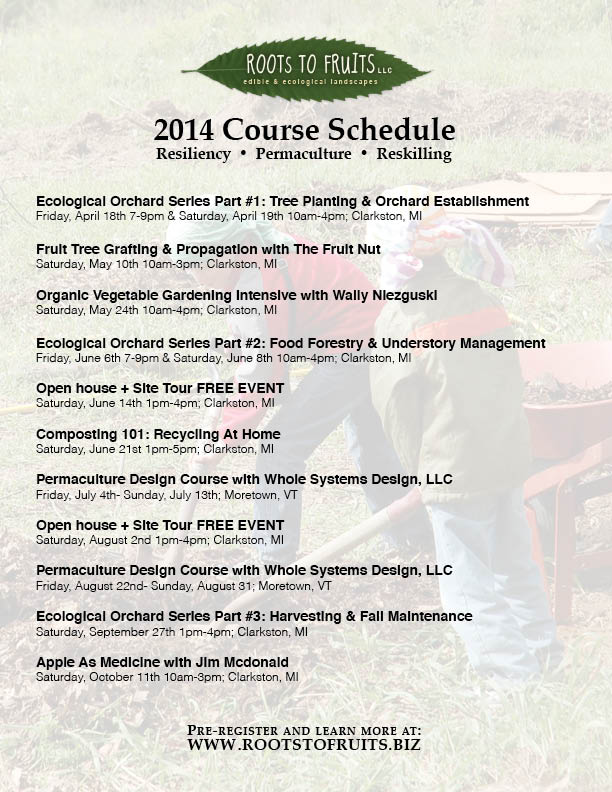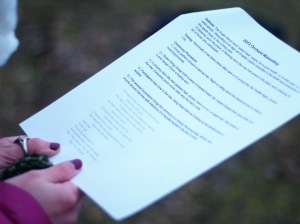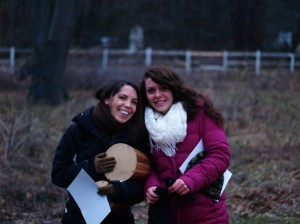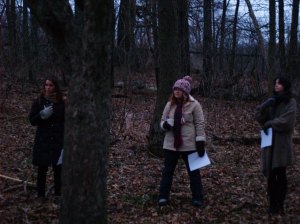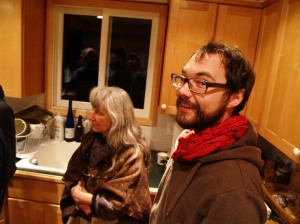I’ve finally gotten around to posting the Roots To Fruits 2014 schedule of events! We are psyched to be offering many exciting classes and workshops in the coming year. More information for each event will be posted to the RTF website soon. Stay posted for registration details…
Tag: local foods
Old Apple Tree We Wassail Thee
 It was an unusually mild January night amidst a long stretch of bone-chilling cold. Warm air blew in during the day raising temps to 45 degrees Fahrenheit…pretty warm for January 19th. This was last Saturday, the evening of our 1st annual wassailing ceremony. ‘Waes hael’ is an Anglo-Saxon word that means ‘to wish well’, or ‘to wish whole’. Orchard wassailing is an old English tradition where each year around January 17th (The Old Twelfth Night) people gather together to perform a ceremony in honor of the apple trees. The ceremony is meant to promote the health of the trees and to ensure a bountiful harvest in the coming season. This age-old custom is still practiced until this day, particularly in England and throughout the British Isles. With apples being a cornerstone to British culture, this tradition was at the center of seasonal festivities and followed the celebration of Christmas.
It was an unusually mild January night amidst a long stretch of bone-chilling cold. Warm air blew in during the day raising temps to 45 degrees Fahrenheit…pretty warm for January 19th. This was last Saturday, the evening of our 1st annual wassailing ceremony. ‘Waes hael’ is an Anglo-Saxon word that means ‘to wish well’, or ‘to wish whole’. Orchard wassailing is an old English tradition where each year around January 17th (The Old Twelfth Night) people gather together to perform a ceremony in honor of the apple trees. The ceremony is meant to promote the health of the trees and to ensure a bountiful harvest in the coming season. This age-old custom is still practiced until this day, particularly in England and throughout the British Isles. With apples being a cornerstone to British culture, this tradition was at the center of seasonal festivities and followed the celebration of Christmas.
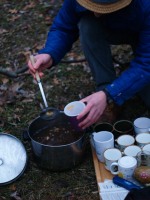
The ancient earth rite begins with the group gathering in a circle around the largest or most significant tree in the orchard, known as The Apple Man, which is meant to represent the rest of the orchard trees… from there the butler, or ‘king’, brings forth a piece of toasted bread; the master, or ‘queen’, then takes the bread, dips it into mulled cider(which all ceremony participants are given), and then hangs the bread on a fruiting spur of the chosen tree. The cider-soaked bread is an offering to the robins, which are thought to be guardians of the orchard. A proper toast is then given and everyone drinks to the tree. The ceremony comes to a finale as the group sings a wassailing song. Everyone bangs on pots and pans, drums, and tambourines to ward off any evil spirits that might be dwelling in the tree and the ceremony is concluded. After researching numerous wassailing traditions and songs, I synthesized this version:
Old apple tree we wassail thee in hope
that thou will bear
For the Lord doth know where we shall be
’til apples come another year
to bear well and to bloom well, and so
merry let us be
Let every man take off his hat
And shout to the old apple tree
(Repeat twice more)
Old apple tree we wassail thee in hope
that thou will bear
Hats full,
Caps full,
Three bushel bags full,
And a little heap under the stairs.
Hip, Hip, Hooray! Hip, Hip, Hooray!
Hip, Hip, Hooray!
That’s a basic overview of one wassailing ceremony; there are many, many slight variations and each has its place in a different locality. The beauty is that it can be adapted to any place, and although there are some general guidelines, anybody can do it anywhere. For me it seemed like a custom worth integrating into our community, and in a very real sense we are only RE-integrating, as a lot of us trace our ancestry to places like the British Isles and other European countries. I speak on behalf of many when I say there is a major hunger for connection in our modern, technologically-rampant culture. There is a hunger for connection to place, there is a hunger for connection to community, and there is a hunger for connection to our customs and traditions which have been stripped away over the last 300+ years. I see it all around me as full moon potlucks, skill share groups, harvest parties, and other community celebrations once again become common. After all, how can something so central to human existence be left behind?
Our first annual wassailing ceremony was met with great interest as 20+ friends and fellow apple-lovers came out to celebrate. We started the evening around 5:30 with the ceremony and a large bonfire in the orchard followed by a lovely potluck indoors. The evening went on with drumming, delicious and seasonally appropriate food and drink, and many wonderful conversations and laughs. Simple gatherings like these bring us closer together as a community and feed the deep hunger within—the hunger for connection.
New Moon: Ground Cherries, Orgonite, Black Currant Tincture, and More…
Its been a few weeks since my last post and I’ve been itching to release some fresh ideas and photos. Things have been a bit crazy lately with selling plants at the farmers markets and working on new Roots To Fruits jobs. Its all very good, just a bit tiring at times. So now, on this new moon, I’ve found some time to put out. Just as everything goes in phases and cycles so does my motivation to write, and with the waxing moon my energy towards writing and managing the blog is on the rise! So expect some frequent posting over the next few weeks.
Its mid-august and the groundcherries in my garden are starting to litter the ground once  again. This has been a tradition for the past several seasons; in fact last year the garden was so inudated w/ self-seeded ground cherries, that access became an issue! But what are ground cherries? Being a member of the Solanaceae family they bear some resemblance to tomatillos or cherry tomatoes except with a much fruitier flavor. Botanically speaking tomatoes are technically a fruit, although they’re often referred to as a vegetable…groundcherries, however, don’t fall short of the fruit category. The common ground cherry(Physalis peruviana), also called cape gooseberry, not to be mistaken with true gooseberries(Ribes spp.), is a self seeding annual that can become rather weedy. Physalis heterphylla is a perennial relative that grows wild throughout eastern NA. I have
again. This has been a tradition for the past several seasons; in fact last year the garden was so inudated w/ self-seeded ground cherries, that access became an issue! But what are ground cherries? Being a member of the Solanaceae family they bear some resemblance to tomatillos or cherry tomatoes except with a much fruitier flavor. Botanically speaking tomatoes are technically a fruit, although they’re often referred to as a vegetable…groundcherries, however, don’t fall short of the fruit category. The common ground cherry(Physalis peruviana), also called cape gooseberry, not to be mistaken with true gooseberries(Ribes spp.), is a self seeding annual that can become rather weedy. Physalis heterphylla is a perennial relative that grows wild throughout eastern NA. I have

found them growing a few times in MI, and Ken Asmus of Oikos Tree Crops now sells the perennial form. Even the annual forms seem to ‘perennialize’ in the sense that they volunteer each year and reliably come back. They’re called ground cherries because they fall to the ground when fully ripe. They can then be collected, dehusked, and eaten fresh. I’ve also heard them called husk cherries because they grow inside a papery protective husk. Nature’s wrapper. The flavor is like the sweetest of tomatoes with fruity-pineapple notes. They are about the size of a grape tomato and contain several small seeds which are barely noticeable. Ground cherries are great dehydrated and I’ve been toying with the idea of using them in salsa, jelly, and wine. Mmmm…

Now that summer has peaked and is waning, we’ve concluded most of the berry pickin’; cane fruits are pretty much done, besides the fall bearing raspberries, blueberries are dwindling but still available, and the Ribes, besides the latest of gooseberries, are now a distant memory. Fortunately they’re blessings are preserved in jams and jellies! The

changing seasons can be difficult to deal with, but its a righteous reminder of the impermanence of all things. Actually its a good way to practice non-attachment. I really, really, am enjoying all of these wonderful zucchinis, but they too will pass! Nothing lasts forever and thats the beauty of it. As small fruits and berries are largely coming to an end, the stone fruits are coming in, and early apples are beginning to ripen. I was in Detroit two weeks ago and was

delightfully surprised to find the number of ripe apples. The odd season paired with the Detroit microclimate created super conditions for tree fruit. Even the peaches weren’t phased by the early season warm spells and late frosts. We even found peach seedlings setting fruit in alleys. Want to start growing fruit? Move to Detroit.



My peach trees didn’t set any fruit this year. Fortunately a few local growers managed to get a small percentage of the usual crop…just enough to bring to market. So the past two weeks I’ve been buying containers of peaches at the market. I belong to a goat milk share where I get a half gallon of organic raw goat milk each week. This week I decided to make some fresh cheese… I was left with a lot of whey. Today I made a lovely smoothy with one cup blueberries, two peaches, and one cup whey. No whey, yes whey… rich in flavor and rich in nutrients!

As promised, here is the blueberry-lavender jam recipe…very simple, no fuss recipe. Give it a try!
What You’ll Need:
- 8 cups fresh blueberries
- 1.5 cups organic sugar
- 1 tablespoon lavender flowers
- 1/4 cup lemon juice
Process:
Step #1: Crush washed blueberries in large cooking pot. Cook on medium heat for 5 minutes.
Step #2: Add sugar and lemon and bring to a boil. Reduce heat, add lavender and cook for 10-15 more minutes on medium heat. Stir consistently.

Step #3: Take off heat and fill jars; store in fridge or for long-term storage place jars in boiling water bath for 15 minutes.
Tips: some recipes suggest removing foam as the jam cooks; I’ve found blueberries to be low foam producers making this step unnecessary.

I choose to plant based on the moon using the biodynamic calendar AKA the Stella Natura. I’ve found much satisfaction(not to mention great results) in following the solunar calendar for my gardening activities. I also make medicine preparations like tinctures and salves on the new moon as to foster the lunar energy put out increasingly from that time until the next full moon. Aside from food, I’ve been curious about the medicinal uses of fruiting plants. Strawberry leaf is a great astrigent used in skin care products, raspberry leaf is high in tannins and has a slew of medicinal actions, and lastly, what I’m concerning myself with today— black currant leaf. Aside from the potent nutraceutical properties of Ribes nigrum fruit, the leaves also possess strong medicinal properties. According to one resource, “Black currant dried leaf is used for arthritis, gout, joint pain (rheumatism), diarrhea, colic, hepatitis and other liver ailments, convulsions, and disorders that cause swelling (inflammation) of the mouth and throat. Black currant dried leaf is also used for treating coughs, colds, and whooping cough; disinfecting the urine; promoting urine flow; treating bladder stones, and as a cleansing tea.” The leaves are astringent and have been used for treating skin blemishes like acne and eczema. Since the plants are just hanging out now and all the berries are long picked, I decided to harvest some leaves for making an alcohol extract.


The late Frank Cook talks briefly about the edible and medicinal uses of black currant…
An exciting new project recently sprouted forth after connecting with a local friend and fellow entrepreneur, Josh Cook. His company, Source Reality, offers products and service for facilitating individuals in connecting to their deepest nature, and reuniting with the source. They offer astrology readings, reiki healing, orgonite, and more. According to the Source Reality website: “Orgonite is the name given to powerful devices which attract negative etheric energy and transmute it into positive, life-giving energy. This is done through a mixture of metals and crystals that are sealed in a resin and formed in specific molds…”

Visit their website to learn more about these unique energy devices. We’re collaborating to do a research experiment using orgonite for influencing plant growth. I’ve conducted a small trial with two hardy kiwi vines grown in containers under identical soil, water, and light conditions… one, however, has an orgonite mold placed in the bottom of the 1gallon pot. We hypothesize that the energetic workings of the orgonite may effect plant growth in some way. Stay tuned for results.


The sun set is telling me to conclude this post and unwind for the evening. Please check back soon for more exciting posts, new articles, and upcoming audio podcasts! Happy growing…

